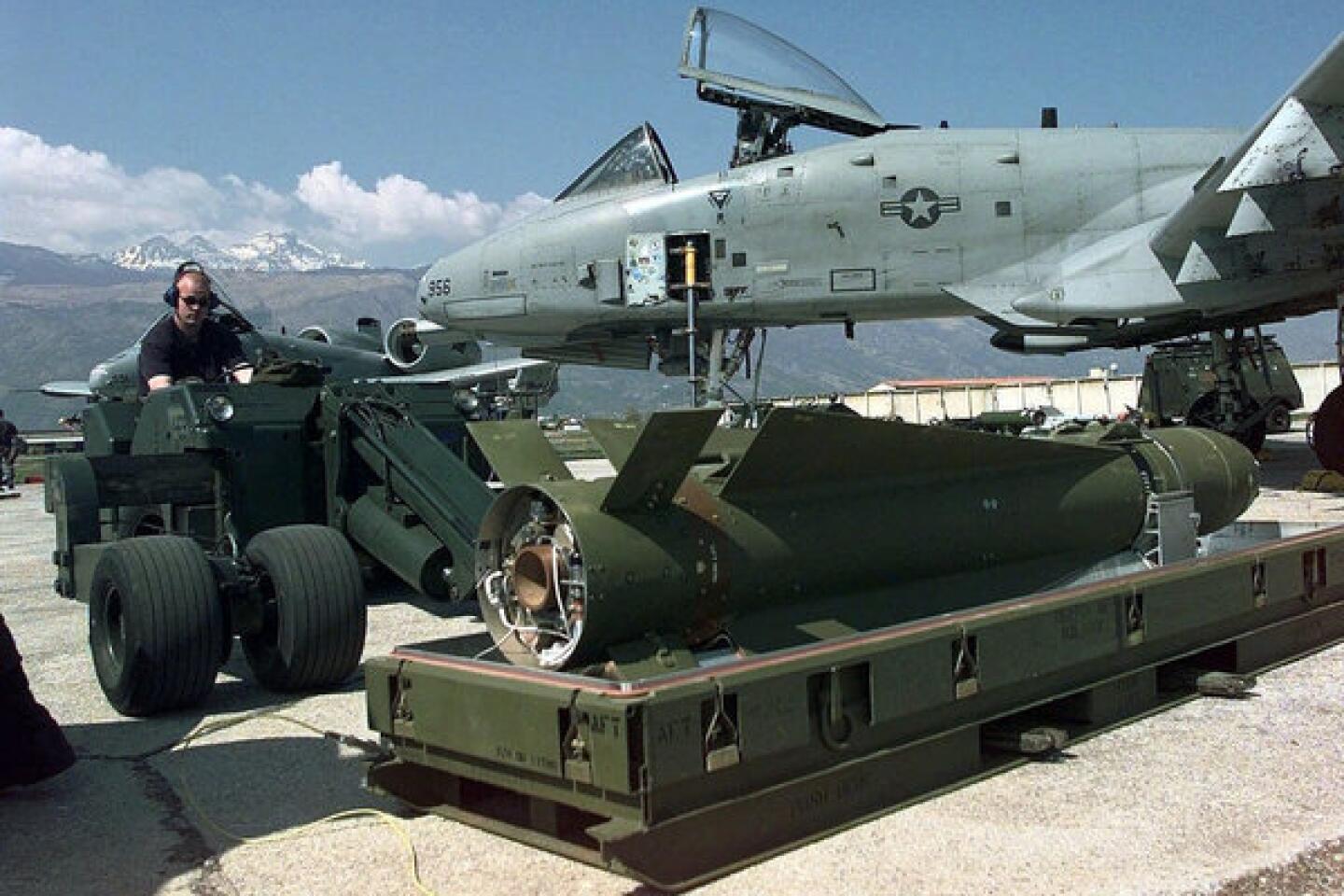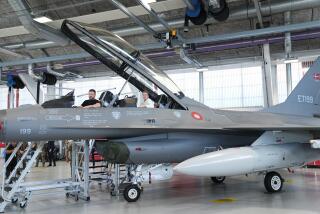Cold War-era ‘Warthog’ plane targeted for retirement amid budget cuts
- Share via
The A-10 Thunderbolt II, a snub-nosed ground-attack plane nicknamed the “Warthog,” is the latest aircraft to find its way onto the Pentagon’s endangered weapons list.
Outfitted with a seven-barrel Gatling gun the size of a Volkswagen Beetle in its nose, the Cold War-era plane has a reputation for tearing apart armored tanks and clearing the way for troops on the ground with its massive 30-millimeter rounds of ammunition.
But the unsightly plane has been in the cross hairs of Pentagon officials in recent years. The Air Force — better known for aerial dogfights and dropping GPS-guided bombs — would rather invest its diminishing funds elsewhere. With billions of dollars in budget cuts and a possible second round of sequestration looming, the military faces tough decisions: keep funding proven planes of the past or invest in high-tech 21st-century weapons.
The Pentagon has yet to release its latest budget or officially signal that the Warthogs are on a kill list. But last month, the Air Force disclosed that eliminating the fleet of 326 aircraft would save it about $3.5 billion over five years.
But taking no chances, A-10 supporters in Congress rushed to offer an amendment this week to the National Defense Authorization Act that would effectively prohibit any additional A-10 retirements until 2021 or later.
Last week, 33 lawmakers wrote a letter to the U.S. secretary of Defense and chairman of the Joint Chiefs of Staff to express “deep concern” about retiring the A-10.
Last month, Sen. Kelly Ayotte (R-N.H.), a member of the Senate Armed Services Committee, blocked the confirmation of the White House nominee for Air Force secretary until she received answers about the plane’s fate.
There’s even a Facebook group called Save the A-10 that was created in August and has garnered more than 4,000 supporters.
The situation serves as a harbinger of the battles to come in an age of budget austerity. The military says it must slash, or “divest,” its older arsenal to save money. But because these entrenched programs support troops and provide thousands of jobs across many states, Congress has continually come to their rescue.
The Pentagon already faces budget cuts of $487 billion over 10 years, and now it must cope with the threat of an additional $500 billion in cuts because of sequestration. The military services are going through an unprecedented process of developing two budgets for 2015 — one with sequestration and one without.
Sequestration cuts would reduce Pentagon spending $52 billion next year. When it comes to programs such as the A-10, some in Congress feel there are better places to cut.
“It would be unconscionable to further cut an asset like the A-10 for budget reasons — increasing the risks our service members confront in ground combat — when equivalent savings could be achieved elsewhere in the Air Force budget without reducing operational capabilities,” said the bipartisan letter sent to Defense Secretary Chuck Hagel and Joint Chiefs Chairman Gen. Martin Dempsey.
The Air Force spends millions of dollars on “conferences, air shows and bloated headquarters staffs,” the letter said.
But major savings — measured in billions rather than millions of dollars — can be made only by cutting an entire fleet, the Air Force has said. That way, the infrastructure that supports the fleet can also be cut, which encompasses thousands of jobs.
The A-10 program also supports 6,000 jobs in the Air National Guard, which flies 90 A-10s in five states. Guard officials have expressed dismay at the prospect of killing the plane.
No one calls into question the A-10’s success at close-air support. The plane is considered one of the best at directly protecting troops on the ground. Pilots do that by laying down fire on enemy tanks, vehicles and strongholds with its high-powered Gatling gun.
The A-10 was designed by Fairchild-Republic in the 1970s around the gun — the heaviest rotary cannon ever mounted on an aircraft. Pilots can shoot short bursts that unleash 140 rounds of ammunition in two seconds. To do so, it must fly low and slow over the battlefield, making it susceptible to ground fire.
But the plane is designed to keep flying even if parts of the wing or one of its engines has been blown to shreds. And the cockpit is surrounded by a bullet-resistant titanium tub. The aircraft has been routinely upgraded over the years.
“The idea is the pilot in the cockpit faces the same threats as the guy in the foxhole,” said Pierre Sprey, an aeronautical engineer who helped design the F-16 and A-10. “They’re in the same fight, and direct contact with one another the whole way through.”
That could be seen in July when two A-10s flying out of Afghanistan’s Bagram air base protected 60 soldiers who were ambushed after their lead vehicle turned over during a patrol in Afghanistan. As the soldiers lay pinned behind their vehicles, taking fire, the A-10s rained down bullets and bombs until the combatants gave up.
This month, Army Chief of Staff Gen. Raymond Odierno told the Senate Armed Services Committee that the “A-10 is the best close-air support platform we have today.”
As good as the A-10 is in close-air support, the military classifies it as a single-role aircraft. That’s the problem. Going forward, the Air Force has said it wants to rid itself of one-mission planes in favor of a fleet of multi-role aircraft. These jack-of-all-trades aircraft can blast apart enemies on the ground and in the sky.
The A-10 can’t dogfight. It’s not stealthy. It’s not supersonic.
“The Air Force never wanted the A-10, and they’ve been trying to get rid of it for years,” said John Pike, director of GlobalSecurity.org, a website for military policy research. “They are manly men and they want jets that shoot down other jets — even though the last time they had an ace was Vietnam.”
The A-10 replacement is the upcoming F-35 fighter jet. Known as the Joint Strike Fighter, the nearly $400-billion program for more than 2,400 jets is centered around a plan to develop a fighter plane that could — with a few tweaks — be used by the Air Force, Navy and Marine Corps.
The idea is that it can take off and land on runways and aircraft carriers, as well as hover like a helicopter. No single fighter aircraft has had all those capabilities. And it is expensive. At $35,200, the F-35’s cost per flying hour is twice as much as the A-10’s, according to the Government Accountability Office.
Though few believe the F-35 will ultimately be able to provide close-air support as well as the A-10, the F-35 certainly falls under the Air Force’s definition of “multi-role.”
Therein lies the dilemma, said Todd Harrison, a defense analyst for the Center for Strategic and Budgetary Assessments in Washington, D.C. If budgets are going to be cut severely, where are the cuts going to come from: expensive new weapons that can carry out more missions, or aging, less-complex weapons?
The F-35 provides 127,000 direct and indirect jobs in 47 states and Puerto Rico. Someone is sure to be upset if there’s a proposal to buy fewer of the planes, Harrison said.
“Everyone knows there needs to be cuts, but few people in Congress are brave enough to actually make them,” he said. “Bottom line is there are going to be a lot of angry people in Congress — no matter what.”
More to Read
Inside the business of entertainment
The Wide Shot brings you news, analysis and insights on everything from streaming wars to production — and what it all means for the future.
You may occasionally receive promotional content from the Los Angeles Times.













